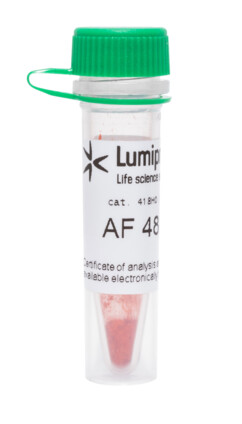Hoechst 34580, blue fluorescent nucleic acid stain
| Cat. # | Quantity | Price | Lead time | Buy this product |
|---|---|---|---|---|
| 0J010 | 5 mg |
$70
|
in stock |

Hoechst 34580 (bisbenzimide, HOE 34580) is a cell-permeant blue-emitting fluorescent dye that binds strongly to adenine-thymine-rich regions in the minor groove of double-stranded DNA. Although Hoechst 34580 can bind to all nucleic acids, AT-rich dsDNA strands enhance its fluorescence considerably.
Hoechst 34580 bound with DNA has excitation/emission maxima at 380/438 nm, respectively. The fluorescence intensity of Hoechst 34580 increases with the pH of the solvent. The unbound dye fluoresces in the 510–540 nm range. The green fluorescence of unbound dye may be observed when an excessive dye concentration is used or the sample is insufficiently washed out. The dye has a considerable Stokes shift between the excitation and emission spectrum, making it worthwhile in multicolor labeling experiments.
Hoechst 34580 is able to penetrate living cells, but it is less permeant than Hoechst 33342. Like all Hoechst family dyes, Hoechst 34580 is less toxic than DAPI, which ensures a higher viability of stained cells.
Hoechst 34580 is used extensively in fluorescence microscopy and flow cytometry for staining chromosomes and nuclei in live and fixed cells. The dye is often used to distinguish condensed pycnotic nuclei in apoptotic cells and cell sorting.
Hoechst 34580 is quenched by bromodeoxyuridine (BrdU), commonly used to detect dividing cells. When BrdU is integrated into DNA, the bromine is supposed to deform the minor groove so that Hoechst dyes cannot reach their optimal binding site. This property of Hoechst 34580 is used to study cell-cycle progression.
The commonly used dye concentration to stain bacteria or eukaryote cells is 0.1–10 μg/mL.
Absorption and emission spectra of Hoechst 34580 (DNA–dye complex)

Recommended protocol
Calculator
Customers also purchased with this product
General properties
| Appearance: | brown powder |
| Molecular weight: | 560.96 |
| CAS number: | 911004-45-0 |
| Molecular formula: | C27H32Cl3N7 |
| IUPAC name: | N,N-Dimethyl-4-[5-(4-methyl-1-piperazinyl)[2,5′-bi-1H-benzimidazol]-2′-yl]benzenamine trihydrochloride |
| Solubility: | water, DMSO, DMF |
| Quality control: | NMR 1H and HPLC-MS (95+%) |
| Storage conditions: | 24 months after receival at -20°C in the dark. Transportation: at room temperature for up to 3 weeks. Desiccate. |
| MSDS: | Download |
| Product specifications |
Spectral properties
| Excitation/absorption maximum, nm: | 380 (complex) |
| Emission maximum, nm: | 438 (complex) |























 $
$ 
